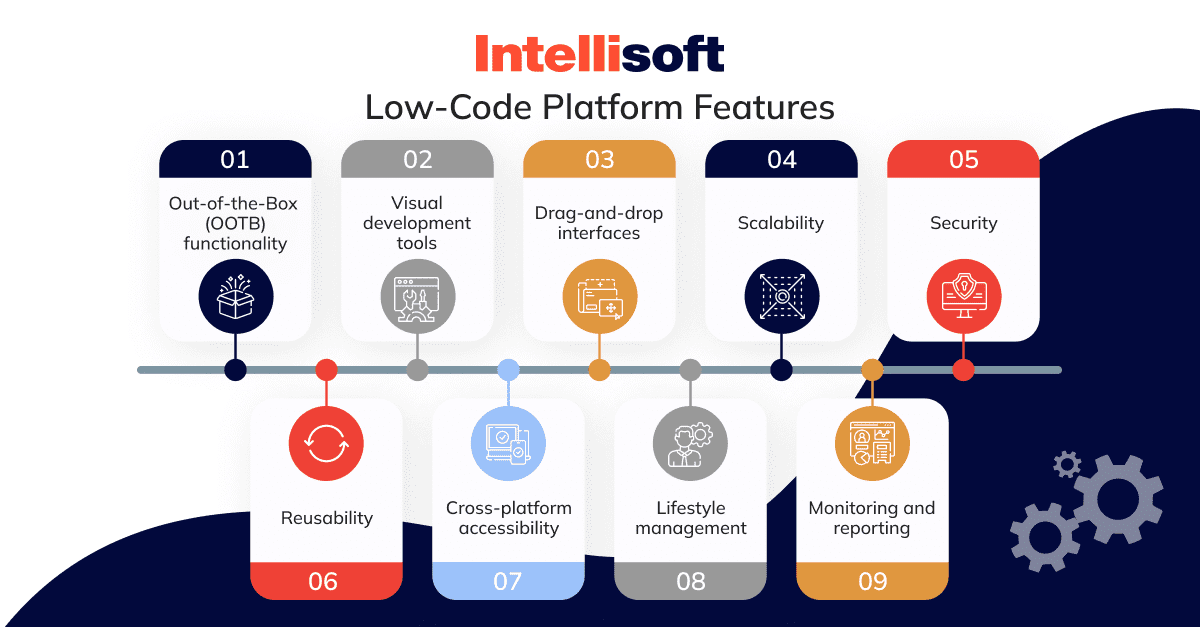Excellent Tips To Picking application development with Low-code platforms
Excellent Tips To Picking application development with Low-code platforms
Blog Article
Benefits Of Low-Code Application Development Terms Of Speed
Visual Development Environment :
Drag-and-Drop Interfaces: Low-code platforms provide visual tools for designing applications. Developers can utilize drag-and-drop tools to quickly assemble applications without writing a large amount of code.
Pre-built components and templates: Many low code platforms have pre-built components and templates, which allow developers to quickly prototype and develop applications.
Coding requirements that are less invasive:
Automated code generation: Low-code platforms produce the code base on models that are visual and maintained by programmers. This helps reduce manual code, and accelerates the process of development.
Reusable Components: Developers are able to make use of reusable components across various projects, thus reducing the time that is spent creating and testing code.
Streamlined Collaboration:
Low-code platforms have a myriad of tools that allow seamless collaboration between teams working on development. These include testing, version control and deployment.
Citizen Development Business users, non-developers and other stakeholders are able to help in the creation of applications through user interfaces that are intuitive. This helps to reduce the bottleneck caused by the lack of availability of professional developers.
Rapid prototyping, rapid iteration, and rapid prototyping
Rapid prototyping. Developers can design prototypes quickly in order to validate their ideas and get feedback. This will lead to a faster iteration cycle.
Simple Modifications: Low-code development is visual-oriented, making it much easier to modify and update apps. It helps speed the process of refining and optimizing applications based on feedback from users.
Pre-built Integrations:
API Integrations. Low-code platform often have pre-built connectors and APIs for popular services which can reduce the time needed to integrate other systems.
Data Integration: The tools that are built into the software simplify and accelerate the process of connecting databases, other data sources, and applications.
Deployment & Scaling
One-Click deployment: A lot of platforms that make use of low-code have an option to deploy applications, which can reduce time and effort.
Cloud-based solutions: Cloud platforms with low-code enable developers to focus on the design and function of their apps rather than worrying about logistics for deployment.
The main advantage of low-code application development with regard to speed, is its capacity to automatize and simplify many aspects in the development process. This allows for rapid delivery of software and faster adaptations to evolving needs. View the top Low-code Platform for application development hints for more advice including push notifications, multiplatform mobile app development, develop cross platform mobile app, app modernisation, push notifications, develop cross platform mobile app, low code development platforms, app platforms, rad application development, develop web app and more.
Low-Code Apps Are Affordable.
Low-code development offers many advantages in terms of cost effectiveness. This makes it an ideal choice for businesses that want to reduce their development budgets while still delivering high quality applications. Here are the major benefits:
Lower Coding Requirement: Low coding platforms eliminate the requirement to write code manually and save developers time and money. The result is lower labor costs.
Lower Developer Resources: As low-code is more efficient and less time to develop, fewer specialized developers will be needed. Costs for hiring and staffing can be significantly reduced.
Speedier time to market
Accelerated Development: Low-code platforms offer visually-based development tools, components that are pre-built, and other tools that allow rapid development of applications. Businesses can introduce their products to market faster. This can lead faster revenue growth and improve your position in the marketplace.
Rapid Prototyping - Businesses can develop and test prototypes in a very short amount of time, which reduces the amount of time required to develop. This allows them to make faster iterations after receiving user feedback.
Lower Maintenance Costs
Simplified Maintenance: Applications built with low-code platforms are typically more simple to maintain due to their modular components and standard architecture. This reduces the ongoing maintenance and support cost.
Automated Patches and Updates Low-code platforms can manage patching and updating applications completely. This means that your application remains safe and always up to date without extensive manual intervention.
Efficient Resource Utilization:
Contributions from non-developers: Low code platforms allow non-developers, like business users, to contribute to the process of development. This decentralization of development processes allows companies to tap into the expertise and expertise of a greater variety of employees.
Optimized IT Resource Use: IT departments will be able concentrate on strategic initiatives, rather than being buried in routine tasks of development. This will increase overall efficiency and productivity.
Price models that can be scaled:
Subscription-Based Pricing: A lot of lowcode platforms have flexible, subscription-based pricing plans that rise in line with usage. This allows business to align spending with actual needs and growth while avoiding significant initial costs.
Pay-as-you go options Certain platforms offer pay-as you-go options, ensuring that businesses pay only for the resources they use, which can be particularly useful for small and new companies with limited funds.
Reduced costs of third-party software:
Low-code platforms have built-in functionality and integrations that could reduce the cost of subscriptions to software and licensing.
Pre-Built integrations: These systems and services can be integrated with other popular services, which eliminates the requirement for custom-designed software and saves both time and cost.
Increased ROI
A faster return on investment: Rapid development and lower costs, coupled with an increased time to market allows businesses to get a higher return on their investment.
Increased Agility. Businesses can quickly adapt the demands of customers and market trends and ensure that they remain relevant. They can also capitalize on new business opportunities when they arise.
Low-cost Training:
User-Friendly Interfaces: The simple interfaces and user-friendly functions of low-code platforms help to reduce the learning curve thus reducing the need to conduct extensive training.
Accessible Resources: A lot of platforms using low-code provide comprehensive training materials, tutorials and support for community members. This eliminates the need for formal education and expenses associated with it.
Collaboration Streamlined:
Collaboration Tools: Collaboration tools integrated aid in coordination and communication within teams, leading to more efficient processes for development, and less costs.
Unified Development Environment. An unified development platform can help reduce expenses and improve workflows by making it easier to manage various tools.
Low-code development is cost-effective since it decreases maintenance and development costs. It also reduces time to market and optimizes the use of resources. Pricing models are flexible. These aspects provide significant economic benefits to companies. Low-code is a fantastic choice for organizations that want to increase budgets while still being able to develop robust, scalable and high-quality software. Check out the top rated inquiry on Legacy application modernization with Low-code for blog advice including software for app development, push notifications android, cross platform app development, rapid action development, cloud software applications, low code development platforms, azure sql databases, ms azure sql, stored sql procedures, application modernisation and more.
Benefits Of Low-Code Application Development In Terms Of Customization And Limitations
Low-code applications are a flexible, balanced approach that takes into account issues and permits customisation. Here are some benefits:
The Challenge of Overcoming Complexity
Simplified Development: Low-code platforms cut down on the complexity of development by providing templates and components that are pre-built, enabling quicker development and deployment for complicated applications.
Guided Workflows: A lot of platforms have guided workflows as well as wizards to help developers navigate through complicated processes, reducing the likelihood of errors and guaranteeing consistency.
Scalability Solutions
Built-in Scalability: Low code platforms include many options that enable the design of scalable architecture, which allows applications to cope with increased load without significant redevelopment.
Performance Monitoring: The tools that monitor and optimize performance help to ensure that applications are efficient regardless of the fact that they are growing.
Security and Compliance
Low-code platforms have built-in security options, such as role-based security access control, encryption, and automated checks for security compliance. These security features address common concerns about security.
Regular updates: Platforms regularly change their security protocols and compliance procedures. This makes sure that applications remain secure from new threats.
Customization:
Extensibility:
Low-code Platforms Support Custom Code Platforms that allow the integration and use of customized code.
Moduls and plugins that are custom-designed Developers are able to create custom plug-ins or modules that have specific features that are tailored to the specific requirements of a company.
APIs and Integration:
API Support - Comprehensive API support permits seamless integration with external services and systems and permits extensive customization.
Third-Party Applications: Lowcode platforms are often built with connectors for third-party applications. This makes it simpler to integrate them and personalize the app.
Flexible Design of UI/UX:
Customizable Interfaces Developers are able to design and customize user interfaces according to specific branding and usability criteria, resulting in a customized user experience.
Responsive Web Design The built-in design responsive features allow applications to be customized in accordance with the screen size and device.
Business Logic Customization
Visual Workflow Builders This tool lets developers develop complex processes using little or no programming. They can create business processes and workflows using visual.
Conditional Logic & scripting: Platforms permit the use of conditional logic, and scripting that is custom-made to handle specific business rules.
Data Management:
Custom Data Modeling: Designers create custom models that meet specific application needs. They can tailor data handling to the business's requirements.
Advanced Data Processing: Integration of advanced tools and capabilities for data processing permits customizations to the way data is processed in an application.
Balance Customization and Limitations
Frameworks and Standards:
Low-code platforms promote industry standards and best practices. This results in top-quality software that is robust and safe.
Governance Frameworks Governance Frameworks: Integrated governance frameworks ensure that any modifications don't interfere with the integrity, compliance, or the security of an application.
Iterative Development:
Rapid Prototyping: The capability to rapidly prototype and test changes allows developers to modify their designs based on feedback from users improving the app to better satisfy the user's needs.
Continuous Improvement: Low-code platforms support constant improvement, allowing ongoing customization and enhancement as business requirements evolve.
User Empowerment
Giving Citizen Developers the ability to be empowered: By giving non-developers the ability to modify their applications using easy-to-use interfaces and low-code platforms, they increase the number contributors who are able to improve and customize applications.
Support and Training: Many platforms have extensive resources for training and support that can assist users in making effective customizations without compromising stability or performance.
Low-code development is a powerful framework that offers a wide range of flexibility while also addressing shortcomings. This ensures that companies can build and maintain applications that are functional and tailored to their specific requirements, while also keeping high standards of quality, security, and the ability to scale.